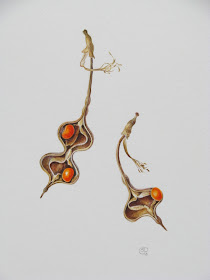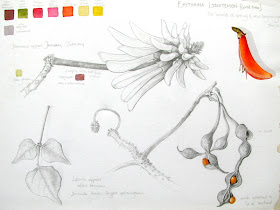“August rain: the best of the summer gone, and
the new fall not yet born. The odd uneven time.”
 |
It’s been yet another messy week of interruptions, but
finally the kids are back in school, and hopefully, life will once more settle back
into a blissful routine. I miss my long painting days!
I have managed to keep the painting cravings at bay by doing
some small studies of dates. Yes, a few fresh dates made their way back to
Ireland with me, to be painted, eaten and hopefully planted. Fortunately they
last a long time, especially when kept in an airtight container in the fridge.
 |
| The changing colour of dates from ripe to riper |
I love this stage of ripeness, known as “Rutab” in Arabic.
The dates are very soft, sweet and moist, quite different to the dried stage
which we are all familiar with. Ideally the dates would be left on the tree to
become dry, but I might try to air-dry these myself.
Meanwhile, I am just
enjoying the wonderful rich reds of the ripe dates. I could never get bored of
painting them, or eating them!
Someone asked me how I paint my highlights, so I have
included a short step by step in this week’s post. Whilst you might not have
fresh dates to paint, the same technique would be ideal for cherries, plums or
rosehips, or any similar round shiny fruit.
Know your colours
Over the years I have accumulated quite a large collection of red paints. In fact, I have far too many paints of all colours (but at least they are cheaper than shoes) ! It’s really not necessary to have a huge number of paints, but it is important to know the cool tones from the warm, and also which colours are transparent, semi-transparent or opaque. The easiest way to do this is by making a colour chart. Lay them all out and decide which are closer to orange and which are closer to purple. Look to see which paints granulate, and which give clear smooth washes. Keep your colour chart close at hand. I often refer back to my colour chart whilst painting to help me decide which colour to use next.
 |
| Red colour charts. I've left some room on the larger one, just in case I happen to come across another red. |
Check your lighting
The first thing that I always do is make sure that the
lighting is good. I prefer the traditional way of lighting from the
left (I’m right-handed). I don’t like artificial lights, particularly overhead
lights, as these can create confusing highlights and shadows. On very overcast
days, I will use a daylight lamp and something shiny to bounce the light back up
onto the subject, but in truth, nothing beats a natural light. You can see an example of a dark rainy day set up here
The date is placed on a small piece of paper to protect the paper beneath and then carefully drawn it out with a 2H pencil
Painting
Find your highlights. It’s important to take note of where
they lie and also how shiny they are. I start with Cobalt violet and then add
cerulean (Schmincke) to the shadows, making sure to leave the highlights clear.
Usually the side which is furthest away from the light has more of a blue tone.
I paint quite wet at this stage and let the colours blend on the paper.
Sometimes highlights are very bright, but here they were soft, so I kept the
edges of the highlights soft by using a second damp brush to blend it all in.
| These are the colours that I used for this date, starting with the ones on the left |
When I first started painting botanicals, I remember feeling
quite confused by the term “disappearing edges”, which is often used to
describe how the surface of a fruit curves away from you. I kept wondering how
an edge can disappear, if I can so obviously see it! A better way to describe
this process is to say “bring the middle bit forward”, although admittedly
that’s a bit of a mouthful! To create this effect, you use warmer colours in
the centre of the fruit, and build up the layers of transparent colours so that
the middle part is the most saturated, leaving the paint around the edges is quite
thin.
I usually start in the center with a bit of winsor orange which is a nice
yellow orange, and then winsor orange-red,
building up the layers of colour and using progressively darker reds,
until I am on to the purples. I paint quite drily, but always make sure that my
brushstrokes follow the form of the fruit (across the width and along the
length, never diagonally), and as the fruit has a smooth surface, I try to
blend it all in with a second damp brush as I go along.
There is always a stage where you look at it and think it
looks dreadful, but persevere!
Save little details like the stalk or tiny blemishes until
the end. Often it’s the little details that can bring it to life.
Have fun!
 |
| Six dancing dates ©Shevaun Doherty 2014 |
"If you chase perfection, you often catch excellence"
William Fowble



































